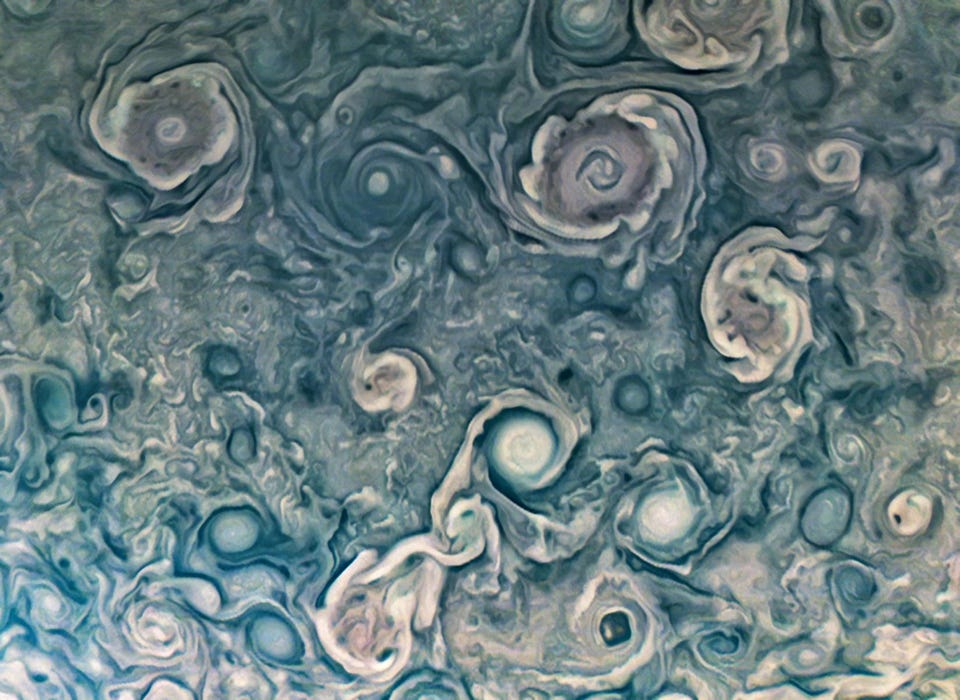Science In Photos: See The Jaw-Dropping New Images Of Jupiter’s Clouds And Its Volcanic Moon Just Sent Back By NASA’s Juno Spacecraft Jamie Carter Senior Contributor Opinions expressed by Forbes Contributors are their own. I inspire people to go stargazing, watch the Moon, enjoy the night sky New! Follow this author to improve your content experience. Got it! Jul 6, 2022, 08:00pm EDT | Share to Facebook Share to Twitter Share to Linkedin Jupiter as seen from NASA’s spacecraft Juno on its perijove 43 on July 5, 2022.
Processed by citizen . . .
[+] scientist Navaneeth Krishnan S. NASA/SwRI/MSSS/Navaneeth Krishnan S © CC BY July 5, 2022 saw NASA’s Juno spacecraft perform its latest dramatic flyby of giant planet Jupiter—and its closest-ever images of its moon Io. In the days since it’s sent back its raw image data across 461 million miles/742 million kilometers through NASA’s Deep Space Network.
That data includes precious new images of Jupiter’s moon Io—the most volcanic body in the entire solar system—seen from just 53,000 miles/86,000 kilometers. For now that’s closer than the spacecraft has been. It follows another close encounter with Io in April 2022 when Juno got to within 66,000 miles/106,000 kilometers.
Images of Jupiter’s moon Io, from Junocam, processed from raw data by citizen scientist Brian Swift. . .
. [+] Image data acquired about 25 hours ago on 2022-07-05 4:22 to 5:33 UTC from distances for 86132 to 107584 km. NASA/JPL-Caltech/SwRI/MSSS/Brian Swift © CC BY The images come from the JunoCam camera on board NASA’s Juno spacecraft, which launched in 2011 and reached Jupiter in 2016.
Since then the bus-sized spacecraft has orbited the giant planet 43 times, producing some jaw-dropping images each time. The spacecraft is in a highly elliptical orbit around Jupiter, coming as close as a few thousand kilometers above the cloud tops during its closest approach. Jupiter’s volcani moon Io as seen from NASA’s spacecraft Juno on its perijove 43 on July 5, 2022.
. . .
[+] Processed by citizen scientist Kevin M. Gill. NASA/JPL-Caltech/SwRI/MSSS/Kevin M.
Gill MORE FOR YOU New Research Finds A Connection Between Domestic Violence And These Two Personality Disorders This Scientist Helps Andean Forests And Ecuador’s Women In STEM Exceptional Fossil Preservation Suggests That Discovering Dinosaur DNA May Not Be Impossible From the gravitational data it’s collected a new study just published saw researchers map out the giant planet’s core. It revealed a high amount of heavy material, which was unexpected. It hints that Jupiter may have devoured planetesimals—the building blocks of the solar system—to aid its growth.
The northern cyclone on Jupiter, as seen by Juno and processed by citizen scientist Navaneeth . . .
[+] Krishnan S. NASA/SwRI/MSSS/Navaneeth Krishnan S © CC BY More than 60,000 images from this data set are also being used by the Jovian Vortex Hunter project, a new citizen science project on the Zooniverse platform led by researchers at the University of Minnesota Twin Cities with support from NASA. It allows volunteers to play an important role in helping scientists learn more about the atmosphere on Jupiter.
Citizen scientists can help astrophysicists categorize tens of thousands of stunning images taken from the Juno spacecraft with just a web browser. Jupiter as seen from NASA’s spacecraft Juno on its perijove 43 on July 5, 2022. Processed by citizen .
. . [+] scientists Kevin M.
Gill. NASA/JPL-Caltech/SwRI/MSSS/Kevin M. Gill Citizen scientists are being asked to identify atmospheric vortices—clouds that have a round or elliptical shape, like hurricanes.
Jupiter’s atmosphere comprises hydrogen and helium yet contains a wide variety of clouds of different shapes and sizes. “There are so many images, that it would take several years for our small team to examine all of them,” said Ramanakumar Sankar, postdoctoral researcher at the University of Minnesota School of Physics and Astronomy, who is leading the project. “We need help from the public to identify which images have vortices, where they are, and how they appear,” said Sankar.
“With the catalog of features (particularly vortices) in place, we can study the physics behind how these features form, and how they are related to the structure of the atmosphere, particularly below the clouds, where we cannot directly observe them. ” The information from the citizen scientists will not only be used to study Jupiter. It will also help to write a computer algorithm that could speed future identification of Jupiter’s atmospheric features by combining computer help with human expertise.
Juno will complete another perijove of Jupiter in August. In December 2023 and January 2024, Juno will get to within just 932 miles/1,500 kilometers of Io. Wishing you clear skies and wide eyes.
Follow me on Twitter or LinkedIn . Check out my website or some of my other work here . Jamie Carter Editorial Standards Print Reprints & Permissions.
From: forbes
URL: https://www.forbes.com/sites/jamiecartereurope/2022/07/06/in-photos-see-the-jaw-dropping-new-images-of-jupiter-and-its-volcanic-moon-just-sent-back-by-nasas-juno-spacecraft/
